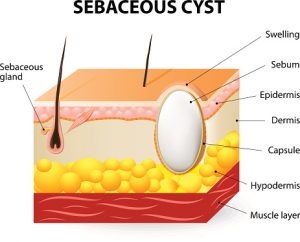 A sebaceous cyst is a noncancerous lump behind the ear, which develops underneath the skin, and while it can be unsightly and sometimes uncomfortable, it’s generally not harmful.
A sebaceous cyst is a noncancerous lump behind the ear, which develops underneath the skin, and while it can be unsightly and sometimes uncomfortable, it’s generally not harmful.
Usually a lump behind the ear, a sebaceous cyst can also show up on the head, back, face, breast, and other parts of the body. They tend to appear most often on the face, neck, and trunk. They are small or large.
Advertisement
Some people who get a sebaceous cyst find that they have no problems with it and require no treatment, but in some situations the cyst can rub up against clothing or other body parts, can rupture or get infected, causing discomfort. In certain cases, a person may decide to have a cyst surgically removed.
Sebaceous cyst (lump behind ear)
Sebaceous cysts are made up of dead skin cells and oil produced by oil glands in the skin. Behind the ear lobe is the more common place to find a sebaceous cyst, but the bump can also be found in the ear canal. Some doctors suspect that their patients get reoccurring cysts because oils are being produced in a skin gland faster than they can be released from the gland.
The oil gland is called the sebaceous gland, hence the name of the cyst.
The cysts may not be cancerous, but they do come with some potential complications. No matter where they are located on the body, sebaceous cysts can become infected. Sometimes, the lump can rupture, thus leading to infection. The cysts can become swollen and inflamed even when there is no infection. In cases where a person has a genital sebaceous cyst, the cyst can cause painful urination and painful intercourse. It is rather rare, but in some situations, sebaceous cysts can lead to skin cancer.
What causes sebaceous cyst (lump behind ear)
Both medical scientists and dermatologists continue to investigate the causes of sebaceous cysts, but what we do know is that the surface of our skin, called the epidermis, is made of layers of thin cells that are always shedding. Cysts form when these cells move deeper into our skin and multiply instead of falling off. These cells form the walls of the cyst. Inside the cyst is a protein, known as keratin. A thick, yellow substance will drain sometimes from a person’s cyst – and that is actually the keratin. Research tells us that the epidermal cell growth is due to a damaged hair follicle from the oil gland in the skin.
People often confuse an epidermoid cyst with a sebaceous cyst, but experts at the world-renowned Mayo Clinic suggest that these are two different types of cysts. They say sebaceous cysts develop from glands that produce oily matter that lubricates hair and skin. The sebaceous gland secretes a mix of fats that include, triglycerides, cholesterol, and wax esters (a fatty acid).
Signs and symptoms of sebaceous cyst
 Since most sebaceous cysts behind the ear are not painful, people don’t notice them. For others, though, sebaceous cyst symptoms can be bothersome.
Since most sebaceous cysts behind the ear are not painful, people don’t notice them. For others, though, sebaceous cyst symptoms can be bothersome.
Here are some typical sebaceous cyst symptoms:
- A small, round lump under the skin
- Redness, swelling, tenderness
- Inflammation or infection
- A tiny blackhead plugging the central opening of the cyst
- Thick, yellow, foul-smelling substance draining from lump
If you have a cyst and notice that it is growing quickly, suddenly ruptures, becomes infected, and/or is painful, you should see a doctor. You should also seek advice from a physician if the spot that the lump is in starts to irritate you or bothers you for cosmetic reasons.
Sebaceous cyst removal can involve a surgical technique or a laser technique, but doctors are careful to point out, especially in cases where the removal is strictly for cosmetic reasons, that both of these techniques have the potential to leave a scar.
Home remedies for sebaceous cyst
Sebaceous cysts treatment is often done right at home because the lump is noncancerous, isn’t painful, and in most cases doesn’t cause any real problems.
While many people are tempted to try to pop or squeeze a sebaceous cyst, like they would with a pimple, this is discouraged as it could increase the chances of infection. Instead, some of the best examples of sebaceous cyst treatment involve simple, natural remedies.
Check out the following list of home remedies for sebaceous cysts:
- Tea tree oil – has both anti-inflammatory and antibacterial properties. It has been known to protect the cyst against infection and reduce reoccurrence of sebaceous cysts.
- Aloe vera – can help if the cyst is inflamed or irritated due to rubbing up against something.
- Castor oil – helps reduce inflammation and any itching associated with the lump.
- Apple cider vinegar – can be helpful if a cyst has become infected.
- Black blood root drawing salve – has been known to pull toxins to the surface of the skin. This 100 percent natural product can be applied to a salve on the lump and then covered with a clean bandage for a couple of days.
- Epsom salt –can be used in a warm bath to help draw infection out of cysts.
- Bee pollen – purifies the blood and is known as an effective method when dealing with skin problems, including sebaceous cysts and acne. To heal cysts, you need to consume bee pollen. It contains bee propolis, pollen, and royal jelly. It is also available in capsule form.
- Turmeric – half a teaspoon of turmeric powder added to one cup of warm milk is said to help in the treatment of sebaceous cysts.
- Antifungal creams – this tends to work on more stubborn, painful cysts. Applying the cream on the infected area and covering it with a bandage is best.
One of the easiest and most effective treatments for sebaceous cysts is using a hot compress. It helps drain the pus and liquid out of the cyst, causing the lump to shrink. If you plan on trying this method, you should make sure that the compress is not very hot. Otherwise, you can burn yourself or generate more infecting bacteria.
Homeopaths have a long list of natural remedies that they suggest to their patients with sebaceous cysts. Some are listed below. If you plan on trying a homeopathic medication, it is important to make sure it does not conflict with any other medications or supplements that you are taking.
- Calcarea carbonica
- Baryta carbonica
- Bromium
- Sabina
- Nitric acid
- Agaricus muscarius
- Mezereum
- Conium
- Ammonium carbonicum
- Kali bromium
- Kali carbonicum
Tips to prevent sebaceous cyst
 It is not unusual for most people to get a sebaceous cyst at some point in their lives. Although they are harmless for the most part, they can be annoying, and nobody really wants to have one on their body.
It is not unusual for most people to get a sebaceous cyst at some point in their lives. Although they are harmless for the most part, they can be annoying, and nobody really wants to have one on their body.
Advertisement
There are ways to lessen the severity of a sebaceous cyst and to prevent it. All it takes is a few easy steps.
- Consume natural herbs to purify your blood.
- Drink plenty of water to drain waste from your body.
- Stick to a nutritious diet rich in vitamins.
- Try antibiotic herbs, which stimulate lymphatic flow.
- When a cysts arises, clean the area with antibacterial soap.
- Let cysts drain naturally, don’t pop or squeeze.
- When a cyst becomes painful, see a doctor.
Sebaceous cysts can be a nuisance, and if they appear on the face or neck they can make a person feel self-conscious. Putting some preventative measures in place can significantly reduce the chances of getting unsightly cysts. Besides, the simple health and hygiene tips above are important for overall good health.
While it is okay to address a sebaceous cyst on your own, if the tips above don’t seem to be helping and you have a cyst that just won’t go way or is painful, it is important to seek medical attention rather than take a stubborn lump into your own hands.
